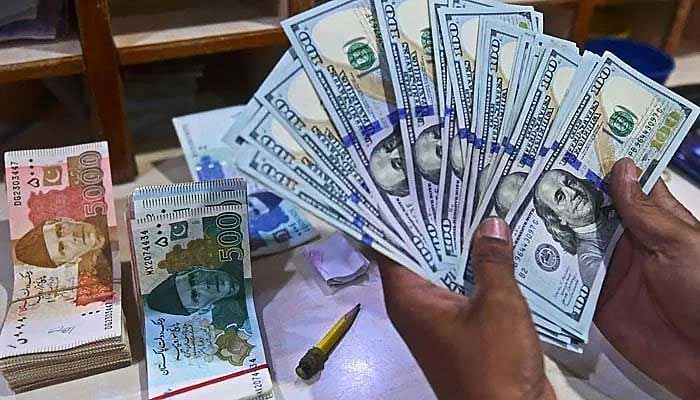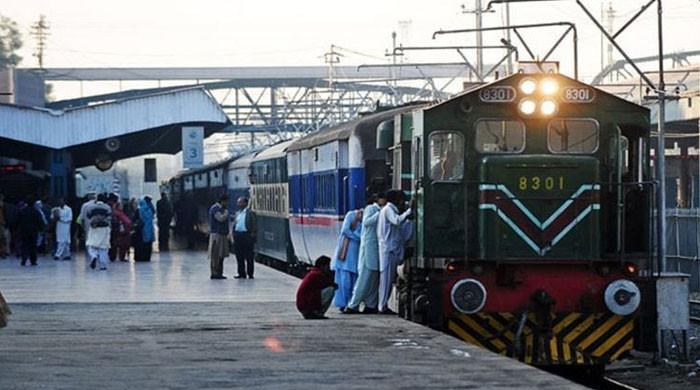Rupee to extend losses against dollar in 2024: report
“Challenging times ahead for rupee,” a financial terminal's report says
December 17, 2023

- Rupee could depreciate another 5-10% next year.
- It closed at 283.26 per dollar in the interbank market on Dec 15.
- "Challenging times ahead for rupee," report states.
KARACHI: The rupee may extend its slide in 2024 as the country grapples with economic challenges such as soaring inflation, hefty debt obligations, a widening external financing gap and dwindling foreign exchange reserves, a report from Tresmark, a financial terminal, said on Saturday.
The rupee, which has dropped 20% against the dollar this year, could depreciate another 5% to 10% next year as Pakistan suffers from near-zero growth, low productivity, higher repayments with fewer avenues for raising forex, the report said.
On December 15, 2023, the local currency closed at 283.26 per dollar in the interbank market. It ended on December 30, 2022, at 226.43.
“Challenging times ahead for rupee,” the report said. “In the current scenario, the economy is grappling with a slowdown in imports (fresh letters of credit openings), a decline in both exports and remittances, creating a stifling effect exacerbated by persistent inflation.”
Tresmark, however, warned that the currency’s weakness could fuel another round of inflation, posing a potential back-breaking burden for all stakeholders.
Average inflation for the first five months of the fiscal year was 28.62%, well above the central bank’s target of 22% for the current fiscal year.
"And if the SBP’s target of 22% for the whole year were to be considered, this would mean, average inflation for the next 7 months to be 17%," Tresmark said. "This looks highly unlikely as a mean consensus for the remainder year is 22.50% — a whole 5% above SBP expectations."
The report said the two top things the authorities need to do is go all out. “Generate avenues for forex liquidity, perhaps the Army Chief’s visit may prove to be productive in this case. Use administrative measures to curb unchecked price hikes including food, transport, et all. And perhaps pray for oil to trickle down to $60 per barrel.”
Foreign analysts and think tanks have reported that Pakistan would experience a shortage of dollars, which might result in the formation of parallel currency markets where the dollar is sold at a rate higher than the official one. The government and central bank, who have been working to stop illicit currency trade and stabilise the rupee, would lose credibility as a result of this.
Pakistan depends on short-term loans and assistance from the International Monetary Fund and other lenders to prevent a default, thus its economic problems might last well into 2024.
This year, there was a lot of fluctuation in the local currency. A delay in the International Monetary Fund's bailout prompted Pakistan's default risks to increase, and political unrest following the incarceration of former Prime Minister Imran Khan drove to record lows for the rupee, which traded at 290 against the dollar in May.
After the country's caretaker government took office in August, there was intense pressure on the rupee versus the dollar. On September 5, the rupee tumbled to a record low of 307.1 versus the dollar. However, since the financial regulator and security agencies of the country started to crack down on illegal foreign exchange trade in grey and black markets, the rupee sharply recovered. The rupee was best-performing currency globally in September.
A survey conducted by Topline Securities showed last week that the majority of financial market participants expect the rupee-dollar parity to range between 290—310 by June 2024.
However, the SBP expects the financial inflows and the forex reserves position to increase with the successful conclusion of the first review of the existing International Monetary Fund's loan programme.
The IMF will release the next tranche of around $700 million from its existing loan programme to Pakistan once it gets approval from its executive board next month.
During the current fiscal year, Pakistan also anticipates receiving $4.5 billion from bilateral and multilateral creditors.
Originally published in The News











